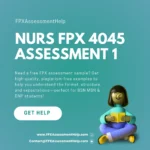NURS FPX 4905 Assessment 2 Define and Analyze Your Healthcare Process Problem or Issue of Concern
Student Name
Capella University
NURS-FPX4905 Capstone Project for Nursing
Prof. Name
Date
Define and Analyze Your Healthcare Process Problem or Issue of Concern
The practicum experience at The Longevity Center offers an opportunity to engage with integrative and regenerative medicine-related activities, focusing on natural treatments and patient-centered care. The practicum will focus on developing skills and enhancing understanding of how novel therapies can treat chronic conditions at a fundamental level through practical learning and involvement in clinical decision-making. This assessment addresses the practicum setting, the clinical and operational decisions, and a key process problem that impacts diagnosis and outcomes of regenerative medicine
Practicum Setting Overview
The practicum will take place at The Longevity Center, an integrated and regenerative medical clinic that combines traditional medical practices with modern alternative treatment methodologies. The facility is committed to delivering patient-centric services by ensuring optimal wellness and utilizing regenerative medicine. Its patient base is diverse, with individuals in good health visiting the center to undergo preventive and anti-aging procedures, while others, who may be professionally defined as chronically ill, utilize regenerative methods of recovery. This broad range enables a wide spectrum of learning on different levels of health and illness (The Longevity Center, 2024a).
The clinical team at the Longevity Center consists of three full-time healthcare professionals. Although it consists of a small number of staff, the team operates in a highly collaborative format, making decisions based on individualized treatment plans, troubleshooting responses to therapy, and long-term patient management. As a practicum participant, I actively engage in clinical and operational decision-making, which provides an excellent opportunity to contribute to the development of strategies for treating patients and enhancing their care. Waterford Clinic also heavily invests in learning and education, promoting education through various resources, including podcasts, literature, and clinical experience (The Longevity Center, 2024a). Such an environment fosters an interactive learning environment, nurturing professional development, critical thinking, and comprehensive patient care.
Clinical and Operational Decision-Making at The Longevity Center
Both clinical and operational decisions at The Longevity Center are integral to everyday practice and have often centered on individualized treatment plans tailored to each patient. Among the most important clinical choices to make will be to choose the right regenerative treatment: Platelet-Rich Plasma (PRP) or stem cell injection; time to treatment; and dose of treatment, as well as deciding whether a patient is qualified to receive the therapy based on thorough diagnostics, including the Longevity blood panel (The Longevity Center, 2024b).
Some of the operational decisions include scheduling procedures efficiently, managing patient flow, ensuring the appropriate documentation of clinical actions, and maintaining sufficient stocks of biological materials and medical equipment. Since it is a practicum process, direct contribution to such decisions can be observed as an evaluator and a member of the healthcare team in discussions. As an illustration, one can point to an age-old example of seeking input, such as examining the results of lab tests to determine how to proceed with treatment or considering adjustments in the injection process, taking sudden cues from the ultrasound (Majewska et al., 2025). This involves a significant amount of troubleshooting patient responses, such as inflammatory responses or sluggish healing, to enhance the effectiveness of therapies.
The major improvements observed in the health outcomes of the primary patients due to such decisions include a reduction in inflammation, faster tissue repair, improved joint and muscle function, and an overall improvement in quality of life. Follow-up assessments, pain scoring, range-of-motion testing, and patient satisfaction surveys have been used to monitor these outcomes (The Longevity Center, 2024a). The integrative philosophy of the clinic informs the decision-making process, making it evidence-informed and patient-tailored to support long-term wellness and the possibility of achieving sustainable recovery.
Identifying a Process Issue Related to Diagnosis and Outcomes in Regenerative Care
One of the major process problems at The Longevity Center concerns the slow treatment and inconsistency in identifying complicated conditions, especially those related to chronic pain, autoimmune disorders, and fatigue syndromes. The situation is different at conventional treatment centers, where the diagnostic process is more structured due to standardized approaches to dealing with illnesses. At The Longevity Center, patients come after consulting several specialists and experiencing little to no success. Such patients usually arrive without a clear diagnosis, but with chronic symptoms that impact the quality of life.
The causes of this diagnostic gap lie in the drawbacks of conventional models, which are primarily oriented towards managing symptoms and therefore do not aim to determine the underlying causes. According to Dutra et al. (2025), traditional treatment has mainly focused on managing symptoms. However, new and improved methods of regenerative therapy, which aim to restore damaged tissues through modern techniques such as stem cell therapy and the development of new skin, are promising but expensive and technologically demanding. It can be seen that many patients are frustrated by the fact that they are either not fully examined in the laboratory or hurriedly, or they are prescribed medicines that offer a short-term solution to the problem, and not a lasting one. As an example, patients who experience chronic joint pain could have been admitted to pain medication or advised to have surgery without considering the non-taxing regenerative therapy, such as PRP therapy, as this may help reactivate the functions of the tissue.
In the Longevity Center, the identified process problem is an impediment to the clinical intake and assessment procedures, where there is no prior evaluation, forcing personnel to redo the diagnostic process. Although blood paneling and regenerative tests are available, the method tends to be slow, which can frustrate the timely initiation of treatment. The importance of this issue is displayed in the health outcomes of patients. Failure to perform or improper performance of timely or accurate diagnosis may result in prolonged suffering, functional loss, greater psychological burden, and finally mistrust of the health system.
According to Slawomirski et al. (2025), the associated costs of misdiagnosis, underdiagnosis, and overdiagnosis result in OECD nations losing an estimated 17.5 percent of their healthcare expenditure (1.8 percent of GDP). Reducing diagnostic errors by half can save as much as 8 percent of all healthcare expenditures. Patient intake data can show that almost 60-70 percent of new customers come in after they have failed in the traditional care facilities, and many of them have suffered months or even years without any relief they can sustain. These delays not only disrupt their physical condition but also their emotional one, which negates the prospect of regenerative treatments being effective. Addressing this process issue is critical to ensuring timely treatment, improving mobility, and reducing chronic pain.
Impact Analysis of Diagnostic Delays on Quality, Safety, and Cost
The existing diagnostic procedure at The Longevity Center presents considerable challenges to both the organization and the clients’ perspectives regarding quality, safety, and cost. Despite the individualized and regenerative approach for which the center is proud, there are no standard diagnostic procedures, which often lead to delays, particularly for new patients who present with poorly defined or incomplete medical histories. Such delays have direct implications for the quality of care, as they can lead to delays in initiating proper therapies. For instance, regenerative treatments, such as PRP or stem cell injections, can lose their efficacy unless they are correctly matched to the specific state and characteristics of a patient’s case (Popescu et al., 2021).
Consequently, the balance of power can shift to the patient, as they may feel dissatisfied and have less confidence in their care, on the one hand, and remain in the same condition for many years despite all treatment efforts. On the one hand, in terms of safety, a late or incorrect diagnosis may persist for an extended period, leading to conditions such as chronic inflammation, autoimmune dysfunction, or soft tissue abrasion. This creates a risk of permanent side effects and may necessitate more radical surgery in the future, contradicting the fundamental idea of regenerative medicine, which is to heal minimally and naturally. Moreover, when patients who have already experienced failed experiences in conventional healthcare arrive at the new healthcare facility, these patients are likely to have undergone one or more medications or procedures and, therefore, are at risk of developing side effects or complications (Kvarnström et al., 2021).
NURS FPX 4905 Assessment 2 Define and Analyze Your Healthcare Process Problem or Issue of Concern
On the cost side, the flaws of its current process exhaust both the clinic and the patients. It also means that the clinic will have to dedicate more time and resources to reassessment, thorough history reviews, individual care planning, and year-long productivity and clinic capacity. For patients, there is an increase in financial strain due to frequent diagnostic procedures, extended care periods, and some procedures that are not covered by insurance. PRP injection costs range from $175 to $4,973 (avg. $707–$1,797), while BMA/BMC treatments average $3,688–$4,379, showing price variation across regenerative procedures (Charnoff et al., 2022). These expenses can deter subsequent care, undermine continuity of care, and impede long-term results.
The root cause of these problems lies in the fact that diagnostic workups performed by patients before bringing them to the Longevity Center were often incomplete and insufficient. Most clients mention that they visit several specialists and undergo many tests, yet still receive no answer to their problem and a prolonged solution. This is corroborated by the intake data at the center, which indicates that approximately 70 percent of patients complain of dissatisfaction with the conventional diagnostic modality. Such data highlights the necessity of implementing a more simplified and standardized intake and diagnosis procedure to enhance the quality of care, increase safety, and reduce the costs of organizations and patients (The Longevity Center, 2024a). A solution to this problem would help the Longevity Center become more efficient and provide prompt, effective care.
Conclusion
The practicum at The Longevity Center provides valuable insights into the strengths and weaknesses of regenerative healthcare medication. Although the center is doing a fantastic job of providing personalized and non-invasive treatments, the challenges in terms of the diagnostic delays experienced by incoming members represent one of the major process problems, which has the potential to impact overall care delivery. Having outlined this gap and conducted a closer analysis of its impact, the discussion will enable stating the significance of simplifying the diagnostic process to improve both patient outcomes and operational performance, as well as lower cost expenditure. This improvement is beneficial not only to patients but also to the clinic, as it will enhance its capability to achieve the clinic’s mission, which is to ensure that patients are well in the long run through advanced natural intervention treatments.
References
Charnoff, J., Rothman, R., Andres Bergos, J., Rodeo, S., Casey, E., & Cheng, J. (2022). Variability in patient-incurred costs and protocols of regenerative medicine procedures for musculoskeletal conditions in the United States. HSS Journal®: The Musculoskeletal Journal of Hospital for Special Surgery, 19(1), 77–84. https://doi.org/10.1177/15563316221105880
Dutra, S., Reigado, G. R., Santos, M., Sardinha, D., Hernandes, S., Marchi, B. L., Zhivov, E., Chambergo, F. S., & Nunes, V. A. (2025). Advances in regenerative medicine-based approaches for skin regeneration and rejuvenation. Frontiers in Bioengineering and Biotechnology, 13. https://doi.org/10.3389/fbioe.2025.1527854
Kvarnström, K., Westerholm, A., Airaksinen, M., & Liira, H. (2021). Factors contributing to medication adherence in patients with a chronic condition: A scoping review of qualitative research. Pharmaceutics, 13(7), 1100. https://doi.org/10.3390/pharmaceutics13071100
NURS FPX 4905 Assessment 2 Define and Analyze Your Healthcare Process Problem or Issue of Concern
Majewska, L., Kijowski, J., & Dorosz, K. (2025). Effect of patient age on Platelet-Rich Plasma (PRP) and fibrin treatments for skin density and thickness: A single-center ultrasound study. Life, 15(2), 308–308. https://doi.org/10.3390/life15020308
Popescu, M. N., Iliescu, M. G., Beiu, C., Popa, L. G., Mihai, M. M., Berteanu, & Ionescu, A. M. (2021). Autologous platelet-rich plasma efficacy in the field of regenerative medicine: Product and quality control. BioMed Research International, 2021, 1–6. https://doi.org/10.1155/2021/4672959
Slawomirski, L., Kelly, D., de Bienassis, K., Kallas, K.-A., & Klazinga, N. (2025). The economics of diagnostic safety. Organisation for Economic Co-operation and Development Health Working Papers . https://doi.org/10.1787/fc61057a-en
The Longevity Center. (2024a). Integrative and regenerative treatments. The Longevity Center FL – Nurturing Health at Its Source. https://www.thelcfl.com/
The Longevity Center. (2024b). PRP Injections. The Longevity Center FL – Nurturing Health at Its Source. https://www.thelcfl.com/our-services/regenerative-therapies/prp-injections/





